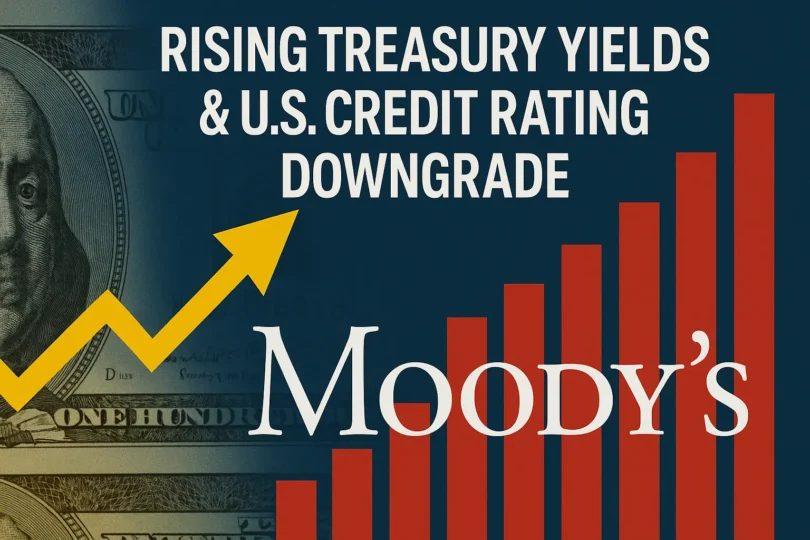Recent developments in the financial markets have been significantly influenced by two pivotal events: the surge in U.S. Treasury yields and the downgrade of the U.S. credit rating by Moody’s. These occurrences have profound implications for investors, policymakers, and the global economy. This article delves into the causes and consequences of these events, providing a comprehensive analysis to aid in informed decision-making.
The Surge in U.S. Treasury Yields
10-Year Treasury Yield
The yield on the 10-year U.S. Treasury note has experienced a notable increase, reflecting investor concerns about inflationary pressures and fiscal sustainability. As of May 19, 2025, the 10-year yield stood at approximately 4.55%, marking a significant rise from previous levels.
30-Year Treasury Yield
Similarly, the 30-year Treasury yield has breached the 5% threshold, reaching levels not seen since November 2023. This uptick indicates heightened expectations of long-term inflation and potential challenges in fiscal policy.
Implications
Rising Treasury yields can lead to increased borrowing costs for consumers and businesses, potentially dampening economic growth. Additionally, higher yields may attract investors to government bonds, diverting capital from equities and other riskier assets.
Moody’s Downgrades U.S. Credit Rating
On May 16, 2025, Moody’s Investors Service downgraded the U.S. sovereign credit rating from Aaa to Aa1, citing concerns over escalating federal debt and persistent fiscal deficits. This move follows similar downgrades by Fitch in 2023 and S&P in 2011.
Rationale
Moody’s highlighted the growing debt burden, projected to reach $36 trillion, and the lack of effective measures to address long-term fiscal challenges. The agency emphasized that successive administrations have failed to implement policies to reverse the trend of large annual deficits and increasing interest costs.
Market Reaction
The downgrade has led to volatility in financial markets, with stock futures declining and Treasury yields rising. Investors are reassessing the risk profile of U.S. government securities, leading to adjustments in portfolios and investment strategies.

Impact on the Stock Market
Short-Term Effects
The immediate aftermath of the credit rating downgrade has seen a decline in major stock indices. The S&P 500 and Nasdaq Composite experienced drops of approximately 1.1% and 1.5%, respectively, reflecting investor apprehension.
Long-Term Outlook
While the downgrade introduces uncertainty, some analysts view the market correction as a potential buying opportunity. Morgan Stanley’s chief strategist suggests that the dip could be temporary, with the market poised for recovery as investors adjust to the new fiscal landscape.
Broader Economic Implications
Borrowing Costs
The combination of rising Treasury yields and a downgraded credit rating may lead to higher borrowing costs for the U.S. government. This scenario could exacerbate fiscal deficits and limit the government’s ability to implement expansive economic policies.
Investor Confidence
A lower credit rating may erode investor confidence in U.S. financial stability, potentially leading to reduced demand for U.S. securities. This shift could have ripple effects across global markets, given the central role of U.S. assets in international portfolios.
Policy Considerations
The current fiscal trajectory underscores the need for comprehensive policy reforms aimed at debt reduction and sustainable economic growth. Policymakers may need to consider measures such as tax reforms, spending adjustments, and initiatives to stimulate productivity.
Resources and Tools
- Explore Investment Opportunities with M1 Finance – Build your custom investment pie with automated rebalancing.
- Plan Your Finances with Personal Capital – Monitor net worth, investments, and retirement.
- Learn Bond Investing on Udemy – Great for beginners seeking to understand fixed income assets.
Enjoyed the Read?
If you found this article helpful, share it with your network and help others stay informed too!
Conclusion
The recent surge in U.S. Treasury yields and Moody’s downgrade of the U.S. credit rating signal a critical juncture for the nation’s fiscal health and economic policy. Stakeholders must navigate these developments with a strategic approach, balancing risk management with opportunities for growth. Continuous monitoring of fiscal indicators and proactive policy responses will be essential in maintaining economic stability and investor confidence.
For further insights and real-time updates on financial markets, consider subscribing to reputable financial news platforms such as MarketWatch and The Wall Street Journal.


Leave a Comment